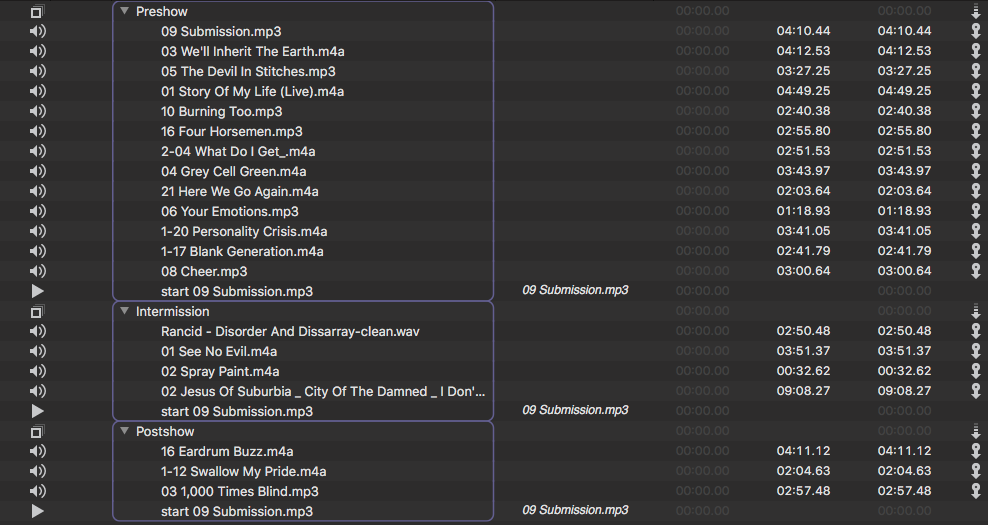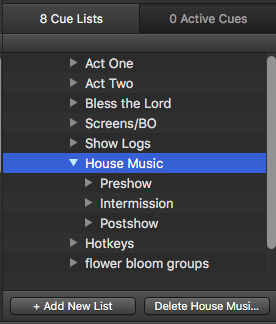Qlab organization – Multiple Cue Lists and House Music
TL;DR:
Work smarter and cleaner with multiple Cue Lists – re-use your work, and get all of that house music out of your main design.
The Story:
Design is a messy process. There are so many elements to consider and plan, and the brain often jumps about, tackling one part and then another, possibly in a less than linear pattern.
Performances can be tense events, because everything has to work precisely as expected every time; or at least consistently, so that any interpretations that occur – the art of performance – can be supported.
The tendrils of design that an application like Qlab allows and encourages means that we need to provide our operators with a clean, organized workflow. Just as you wouldn’t patch 32 XLR cables into a snake, leaving them tangled and unlabeled, you should also strive to create a Qlab workspace that makes sense to the designer, as well as to the operator should problems arise or changes need to be communicated.
Once a show has entered the later stages of tech, I want to be sure, as a designer, that the show feels like the real thing to the operator and everyone else. That is the point of rehearsals, right?
The Esoteric Bit:
A show programmed in Qlab can end up with a LOT of nested cues, and what I don’t want to leave the operator with is a GO button that then cascades through a dozen groups and interdependent fades, where half of the screen scrolls on its own as the computer completes the cue. (I originally thought that collapsing a group in my Cue List would hide some of the sausage making of my show, but no, often times things expand and make a visual mess.
Let’s take house music, as an easy example. Doors open at 30 minutes before curtain, so you need a bunch of music tracks to play, right? In my opinion, no one needs to see 8 songs in the first cue, which is even before the show starts! It’s unnecessary, it’s cluttered visual input for the operator, and depending on how it is programmed could open you up to errors as changes are made (“There was an autofollow on the last preshow song and the show started accidentally!”)

Back in your main Cue List – which I often call “Act One” or some other obvious name – create a Play cue, which targets the new Preshow group you’ve created – simple as drag and drop, like any other targeting.

Now, at the top of your show, you’ll only have one line, instead of all of those songs! A Fade & Stop cue targeting that group will allow you to fade it out on demand, no matter what song is currently playing.
I also use this multiple Cue List approach when creating soundscapes – talk about not wanting to see all of the sausage making that goes into sound design! The added benefit is that if that soundscape comes up in the show more than once, I can just keep invoking it with play cues, instead of copying the ENTIRE soundscape and all of its nested groups. If I make a change to the soundscape, I only have to fix it in one place, which will update it in every instance.

I am aided by the fact that my soundscapes are almost always semi-complicated, randomly-generated looping beds, so being used more than once or twice doesn’t mean I have to make adjustments to keep them from being monotonous or obviously re-used.
NOTE: Regarding house music – I have gotten into the habit, on more and more shows, to add a Play cue in my preshow playlist, at the end of the group. It targets the first song, to loop back into the playlist. You never know when there might be a hold on the house, and you don’t want to run out of music. I try and curate my house music very carefully, and hate repeats – but even with planning for more music than I need (that might never be heard), it’s a nice safety valve to have. This is useful for intermission as well. In the example above, between the amount of curated music I had and the way the show ran, I used the the top of my preshow as my loop target, which reduced the likelihood that audience members would hear music repeat.
Cheers!
-brian
